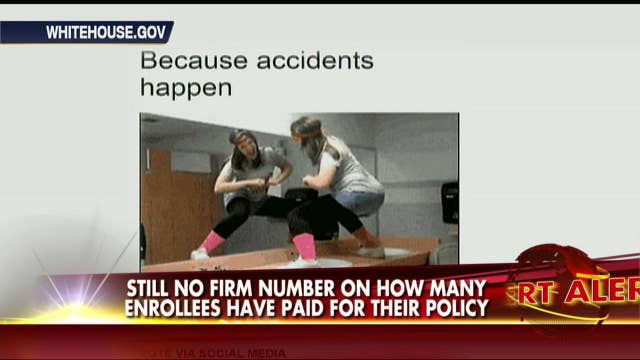ObamaCare Week 26: New Enrollment Milestone
With a little more than a week left to sign up, enrollment on state and federal health exchanges under the Affordable Care Act hit 5 million people this week, as the enrollment figures move closer to the White House’s original goal of 7 million.
On Monday the Department of Health and Human Services announced the new figures, but the report didn’t include a demographic breakdown. Last week, HHS reported 4.2 million people had selected insurance plans, with 25% being between the ages of 18 and 34. It’s also still not clear who has paid their first month’s premium.
Paul Howard, director of the Center for Medical Progress at the Manhattan Institute, says that the jump is “huge” from last week to this week, but that the true number of enrollees is likely lower, as there are reports that as many as 20% have not paid their first month’s premium, which is how the insurance industry traditionally defines an enrollee.
“I take the administration’s new proclamations with a hefty dose of salt,” Howard says.
Larry Kocot, visiting fellow at the Brookings Institution, adds that while open enrollment period is ending, there’s still much work to be done.
“It’s the end of enrollment period, but the beginning of a fixing period,” he says. “Everyone is high-fiving, but the race is just beginning.”
The Uninsured, Not That Interested
On Monday Bankrate.com released a report that one-third of uninsured Americans say that they plan to stay that way.
“This is a population that is notoriously hard to get at,” Howard says of the uninsured. “The administration is trying to push a big rock uphill at this point.”
But Kocot isn’t as concerned with interest as he is with attrition rates, or rates of people who fail to pay for their premiums and actually fully enroll.
“The enrollment number is accelerating and there is a campaign like feel to this, because as you push people to enroll, there’s a lot of encouragement,” he says. “But will they pay their initial premium, and continue to do so, especially if they didn’t have insurance in the first place?”
Another Glitch? Not so Fast
Another glitch on the federal exchange was discovered by the Philadelphia Inquirer on Friday. The newspaper reported HHS was using 2014 federal poverty level guidelines to give site visitors calculations on subsidies, while the ACA specified using 2013 poverty guidelines.
That mean when enrollees were “window shopping” to see what their potential costs would be under the plans, they were getting incorrect estimates. The law gives subsidies to those making up to 400% of the federal poverty level, about $45,000 for an individual and $94,000 for a family of four.
But Howard says while the glitch is certainly not good news, it also isn’t substantial. If and when a person decides to enroll, their subsidy calculations should be correct.
“The federal poverty level doesn’t change that much from year-to-year,” Howard says. “So the difference wouldn’t be that substantial. And if people are that price-sensitive, at the bottom end, it may look like a bit too much money.”
